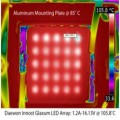2016-07-25
Lexington Luminance plaintiff filed against Google for using patent infringed LEDs in two Google Nexus phones has taken a new turn recently, reported The National Law Review.
Continue reading →
2016-05-04
ZEDGE Materials Inc. (“ZEDGE”), a Taiwan-based company with focus on inventing hitech materials for LED lighting and other industrial products, successfully launched its proprietary thermal radiation material at the Light + Building Fair Frankfurt (“the Fair”) 2016. The material, which consists of a simple ceramic based coating applied on the LED substrate, is innovatively designed to replace the function of heat sink in high power LED lighting (bay light, down light, street lamp, light engines, etc).
Continue reading →
 2012-06-20
2012-06-20
Daewon Innost has made a breakthrough on its Glaxum LED Array family of chip on board (COB) modules, which it claims to achieve the LED industry’s best thermal dissipation performance. The proprietary Nano-Pore Silicon Substrate (NPSS) technology developed by Daewon Innost led to thermal impedance of 0.41°C/W. Daewon Innost’s NPSS is created by applying semiconductor lithography to silicon wafers, allowing for 50µm-pitch interconnection between gallium nitride (GaN) LED chips; conventional metal-core printed circuit boards (MC...
Continue reading →
 2011-11-16
2011-11-16
Over the recent years, the global LED capacity has been expanding rapidly, which is attributed to the booming growth of LED backlight and LED lighting market triggered by the capacity expansions of LED upstream and downstream players. LED sapphire substrate industry is the upstream sector most relevant to the LED chip industry, as sapphire substrate is one of the most important materials of LED chips. The development and directions of related equipment makers are also closely followed by the market. LEDinside conducted an exclusive interview with Cheryl Diuguid,...
Continue reading →
2009-03-18
Silicon carbide is also called "emery powder" or "refractory sand." The usual manufacturing process of SiC is to combine silica sand, tar (or coke), woodchip (and salt when manufacturing green SiC) and other materials in an electric resistance furnace at a high temperature. Silicon carbide is usually divided into two categories, the black SiC and the green SiC, both having a hexagonal crystal structure, a density of 3.2 -3.25g/cm³ and microhardness of 2840-3320kg/mm2.
Continue reading →
 2012-06-20
2012-06-20
 2011-11-16
2011-11-16